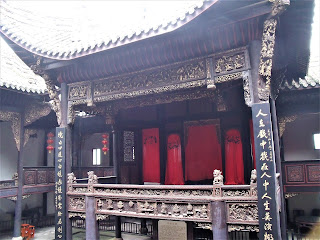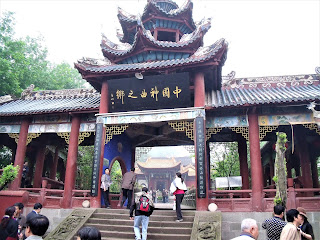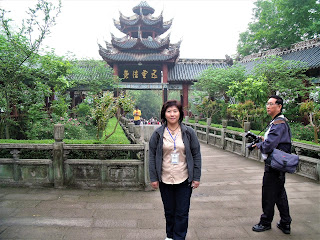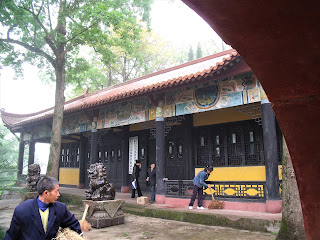DAY 8
10 April
2009
River
Cruise and Excursion to Ghost City
Today it’s
the third day onboard Yangtze 1. The shore excursion for the day was tour of
Ghost City. The ship berthed at Fengdu Port and we disembarked and walked on a
narrow floating jetty ashore. Thereafter we went up to Ghost City by cable car.
It is a massive complex of buildings, shrines, temples and monasteries dedicated to the afterlife located on the Ming Mountain.
Ghost City
Gate of Hell
Emperor's Palace (Tianzi Palace)
Bridge of Troubled Water (Naihe Bridge)
Returning to ship
Captain
Farewell Dinner with performances provided by ship’s crew and passengers.
Explanatory
notes on Ghost City ( from China Discovery )
Fengdu Ghost City (丰都鬼城) is among the most popular attractions for Yangtze
River cruise visitors to China with its famous constructions and displays of culture of “ghost”
and the hell and the important function of spreading the traditional values in Confucians, Taoist, and
Buddhist believes, and the value of “good people will be treated well, and
bad people will be punished after death”. Located on Mingshan Mountain (名山), at the north bank of Yangtze River at Fengdu County in
Chongqing, Fengdu Ghost Town is nearly a must-go place for Chongqing visitors
and serves as the first shore excursion site for Yangtze cruises. Besides, it
is not only “National AAAA Tourist Attraction”, but also a “Famous Cultural
& Historical City” originated from the Han dynasty in ancient China, for
almost 2,000 years old.
Fengdu Ghost City has no ghosts at all. Among all the versions
about the formation of Fengdu Ghost City, the most told is the story about
immortalization of Yin and Wang. According to the legend, two people called Yin
Changsheng (阴长生)
and Wang Fangping (王方平)
came to Fengdu to try to cultivate vital energy and later became immortals.
People later in Tang Dynasty misnamed them “Yinwang” by combining their family
names of “Yin” and “Wang” together into “Yinwang”, which means the “King of
Hell”. Therefore, Fengdu Ghost City got its name. Afterwards, with the
non-stopping renders in the literary works for long time, the reasonable
combination of Chinese culture about ghost with the Buddhism, Taoism and
Confucianism, the mix of local Ba-Yu culture and others from the external
regions, the collision of multiple art styles of architectures, sculptures and
paintings, the well-known “Culture of Ghost City” finally came into shape, and
Fengdu Ghost City is treated as the “destination
for the soul of deceased people”. Therefore, if you are interested in the
so excellent combining work, you can take some time to enjoy in Fengdu Ghost
City.
Bridge of Troubled Water (Naihe Bridge)
The Bridge of Troubled
Water or Naihe Bridge (奈何桥) is situated at the
half way on Mingshan Mountain. It is regarded as a bridge connecting the past
and present, the hell and the real world. the left bridge is for health
symbolizing being healthy each year, while the left one is for wealth standing
for being rich every year. For couples, you could walk together with hand in
hand in even steps, and for single visitors, odd steps, so that you can live
happily and peacefully. It is legendarily said the Naihe Bridge is the first
test among all the “Three Tests” for people after death, and the dead people would
drink the Mengpo soup, walk through that bridge, and then forget all the things
happened in the previous life and get the next new life. According to the folk
tales, after death, while walking through the bridge, virtual people will have
God and Buddha to protect, while the evils will be punished to fall in the
“pool of blood” and be tortured by the snakes and dogs in the muddy wave. So
every year on the pilgrimage occasion, many pilgrims would through copper
coins, ghost money, and stirred rice into the pool for the hungry ghosts.
Emperor’s Palace (Tianzi Palace)
Emperor’s Palace (天子殿) facing the east was
firstly built in West Jin Dynasty, about over 1600 years, and the present
standing construction was built in 1663, over 300 years old. This palace covering
a whole size of 2,431 s. q. m., is the key part of Fengdy Ghost City, and also
the most historical, largest, and best preserved temple construction on the
Mingshan Mountain. That is the place of the “Maya” who is the “King of Hell”.
It consists of an archway, gate, and the palace on an axis. And here in front
of the gate, people would do the second test. Dead people are required to stand
on the stone there on one foot. And good people can stand for 3 minutes,
however, bad people can’t do that and will be punished to the hell.
Apart from that, in
the palace, there imitates the scene in the hell with the thick atmosphere of
dark and gloom. You could see the statues of the king of hell, officials of
different appearances, and many torture scenes displayed there. And that also
expresses the opinion of praising virtue and punishing vice.
Gate of Hell (Guimen Gate)
It is legendarily said
that the Gate of Hell (鬼门关) is the only way to the hell. Whoever coming
here would have to get the check of the road pass which is the evidence to
register in the hell after death. With that pass, dead people can go to the
hell and go up to the heaven for the upcoming of the next life without any
obstacles.
























































































